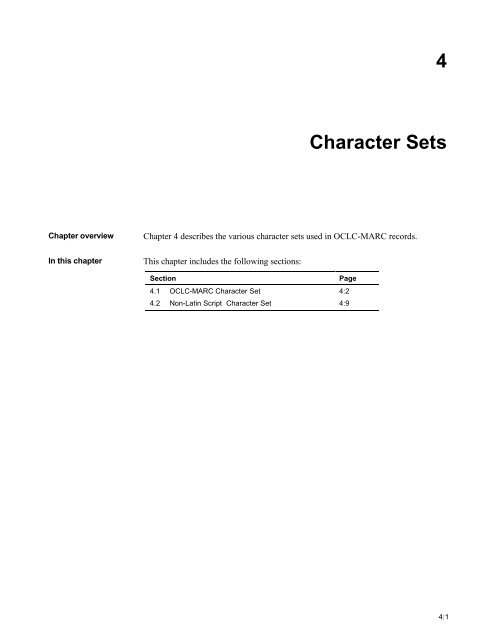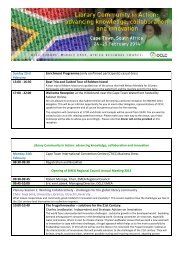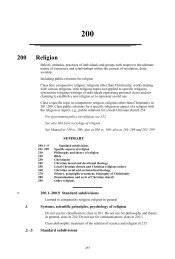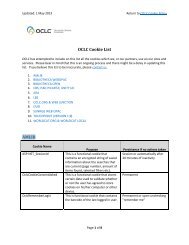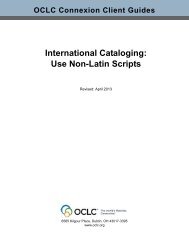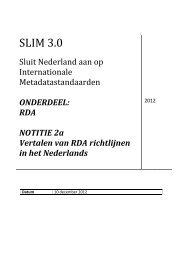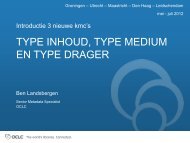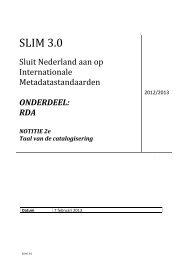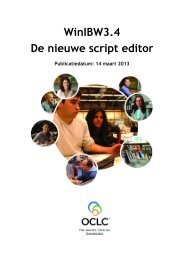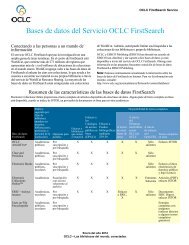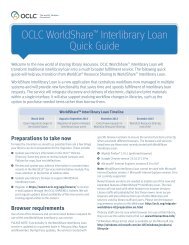4. Character Sets - OCLC
4. Character Sets - OCLC
4. Character Sets - OCLC
You also want an ePaper? Increase the reach of your titles
YUMPU automatically turns print PDFs into web optimized ePapers that Google loves.
Chapter overview<br />
In this chapter<br />
4<br />
<strong>Character</strong> <strong>Sets</strong><br />
Chapter 4 describes the various character sets used in <strong>OCLC</strong>-MARC records.<br />
This chapter includes the following sections:<br />
Section Page<br />
<strong>4.</strong>1 <strong>OCLC</strong>-MARC <strong>Character</strong> Set 4:2<br />
<strong>4.</strong>2 Non-Latin Script <strong>Character</strong> Set 4:9<br />
4:1
<strong>4.</strong>1 <strong>OCLC</strong>-MARC <strong>Character</strong> Set<br />
Introduction<br />
Hexadecimal codes<br />
Nonstandard<br />
character sets<br />
Diacritics<br />
This section defines the character sets used in <strong>OCLC</strong>-MARC records. The characters<br />
are represented on the records as 8-bit binary codes. The hexadecimal representation<br />
of all 256 possible codes is followed by the definition of the corresponding character<br />
or function code.<br />
Codes 00 through 1A (except 01, 02, 03, and 11), 7F, and 1C are used only for<br />
data transmission control and should not appear in any record<br />
Codes 01, 02, 03, and 11 (in addition to being used for data transmission control)<br />
formerly identified the transaction type in byte 22 of a record leader<br />
Code 50 (defined in the table as the letter p) was also formerly used in byte 22 of<br />
the leader to identify an All Produce transaction<br />
Codes 90, 91, 93, and 94 are undefined in the table and were formerly used in<br />
byte 22 of the leader to identify an offline transaction<br />
The nonstandard character sets are produced by means of an escape code<br />
(hexadecimal 1B) followed by a code that indicates the character set (with characters<br />
for consideration). The new character set remains in effect until another escape code<br />
indicates a change to a different character set.<br />
For example, the character sequence N- 2 –2 is represented as NESCp–2ESCs–2 (in<br />
hexadecimal, 4E 1B 70 2D 32 1B 73 2D 32). Note that code 2D 32 represents both<br />
the normal –2 and the superscript - 2 in the 2 character sets. All fields are assumed to<br />
begin in the standard character set.<br />
Diacritical marks are characters printed over or under another character. They have<br />
codes in the range E0 through FF and follow the character to which they apply. For<br />
example, ö (lowercase o umlaut) is represented as o¨ (in hexadecimal 6F E8).<br />
4:2 <strong>OCLC</strong>-MARC Records
<strong>4.</strong>1 <strong>OCLC</strong>-MARC <strong>Character</strong> Set (continued)<br />
Standard character set<br />
H 1<br />
E<br />
2 X<br />
0 1 2 3 4 5 6 7 8 9 A B C D E F<br />
0 SP 0 P p ‘ <br />
1 ! 1 A Q a q Ł <br />
2 " 2 B R b r Ø ø <br />
3 # 3 C S c s Ð đ <br />
4 $ 4 D T d t Þ þ <br />
5 % 5 E U e u Æ æ <br />
6 & 6 F V f v Œ œ <br />
7 ' 7 G W g w ´ ˝ <br />
8 ( 8 H X h x · <br />
9 ) 9 I Y i y ♭ ₤ <br />
A : J Z j z <br />
B ESC + ; K [ k { ± <br />
C , < L \ l<br />
D<br />
E<br />
F<br />
ILLEGAL<br />
CHARACTER<br />
CODE <br />
<br />
RECORD<br />
TERM. - = M ] m } <br />
FIELD<br />
TERM. . > N n ’ <br />
DELIM-<br />
ITER / ? O o <br />
<strong>4.</strong> <strong>Character</strong> <strong>Sets</strong> 4:3
<strong>4.</strong>1 <strong>OCLC</strong>-MARC <strong>Character</strong> Set (continued)<br />
Standard character set (continued)<br />
Hex Graphic Name and/or Function Hex Graphic Name and/or Function<br />
00 Null 20 20 Space<br />
01 Start of heading 21 ! Exclamation point<br />
02 Start of text 22 “ Quotation marks<br />
03 End of text 23 # Number sign<br />
04 End of transmission 24 $ Dollar sign<br />
05 Enquiry 25 % Percent sign<br />
06 Acknowledge 26 & Ampersand<br />
07 Bell 27 ‘ Apostrophe<br />
08 Backspace 28 ( Opening parenthesis<br />
09 Horizontal tabulation 29 ) Closing parenthesis<br />
0A Line feed 2A * Asterisk<br />
0B Vertical tabulation 2B + Plus<br />
0C Form feed 2C , Comma<br />
0D Carriage return 2D - Hyphen (minus)<br />
0E Shift out 2E . Period (decimal point)<br />
0F Shift in 2F / Slash<br />
10 Data link escape 30 0<br />
11 Device control 1 31 1<br />
12 Device control 2 32 2<br />
13 Device control 3 33 3<br />
14 Device control 4 34 4<br />
15 Negative acknowledge 35 5<br />
16 Synchronous idle 36 6<br />
17 End of transmission block 37 7<br />
18 Cancel 38 8<br />
19 End of medium 39 9<br />
1A Substitute 3A : Colon<br />
1B Escape 3B ; Semicolon<br />
1C File separator (FS) 3C < Less than<br />
1D Record terminator (GS) 3D = Equals<br />
1E Field terminator (RS) 3E > Greater than<br />
1F ‡ Subfield delimiter (double dagger)<br />
(US)<br />
3F ? Question mark<br />
4:4 <strong>OCLC</strong>-MARC Records
<strong>4.</strong>1 <strong>OCLC</strong>-MARC <strong>Character</strong> Set (continued)<br />
Standard character set (continued)<br />
Hex Graphic Name and/or Function Hex Graphic Name and/or Function<br />
40 @ Commercial at sign 60 ` Spacing grave/grave accent<br />
41 A 61 a<br />
42 B 62 b<br />
43 C 63 c<br />
44 D 64 d<br />
45 E 65 e<br />
46 F 66 f<br />
47 G 67 g<br />
48 H 68 h<br />
49 I 69 I<br />
4A J 6A j<br />
4B K 6B k<br />
4C L 6C l<br />
4D M 6D m<br />
4E N 6E n<br />
4F O 6F o<br />
50 P 70 p<br />
51 Q 71 q<br />
52 R 72 r<br />
53 S 73 s<br />
54 T 74 t<br />
55 U 75 u<br />
56 V 76 v<br />
57 W 77 w<br />
58 X 78 x<br />
59 Y 79 y<br />
5A Z 7A z<br />
5B [ Opening bracket 7B { Left curly bracket/opening curly<br />
bracket<br />
5C \ Reverse slash 7C | Illegal character (fill character)<br />
5D ] Closing bracket 7D } Right curly bracket/closing curly<br />
bracket<br />
5E ^ Spacing circumflex/circumflex<br />
accent<br />
7E Spacing tilde/tilde<br />
5F _ Spacing underscore/low line 7F Delete<br />
<strong>4.</strong> <strong>Character</strong> <strong>Sets</strong> 4:5
<strong>4.</strong>1 <strong>OCLC</strong>-MARC <strong>Character</strong> Set (continued)<br />
Standard character set (continued)<br />
Hex Graphic Name and/or Function Hex Graphic Name and/or Function<br />
80 A0<br />
81 A1 Ł Polish L, uppercase<br />
82 A2 Ø Scandinavian O with slash,<br />
uppercase<br />
83 A3 Ð D with crossbar, uppercase<br />
84 A4 Þ Icelandic thorn, uppercase<br />
85 A5 Æ AE, uppercase<br />
86 A6 ΠOE, uppercase<br />
87 A7 ´ Míàgkiĭ znak<br />
88 A8 · Dot in middle of line<br />
89 A9 ♭ Musical flat<br />
8A AA Subscript patent mark<br />
8B AB ± Plus or minus<br />
8C AC Hooked O, uppercase<br />
8D AD Hooked U, uppercase<br />
8E AE ’ Alif<br />
8F AF<br />
90 B0 ‘ Ayn<br />
91 B1 Polish L, lowercase<br />
92 B2 ø Scandinavian o with slash,<br />
lowercase<br />
93 B3 đ d with crossbar, lowercase<br />
94 B4 þ Icelandic thorn, lowercase<br />
95 B5 æ ae, lowercase<br />
96 B6 œ oe, lowercase<br />
97 B7 ˝ Tvërdyĭ znak<br />
98 B8 Turkish I, lowercase<br />
99 B9 ₤ British pound<br />
9A BA Eth<br />
9B BB<br />
9C BC Hooked o, lowercase<br />
9D BD Hooked u, lowercase<br />
9E BE Script el, lowercase<br />
9F BF<br />
4:6 <strong>OCLC</strong>-MARC Records
<strong>4.</strong>1 <strong>OCLC</strong>-MARC <strong>Character</strong> Set (continued)<br />
Standard character set (continued)<br />
Hex Graphic Name and/or Function Hex Graphic Name and/or Function<br />
C0 ° Degree sign E0 Pseudo question mark<br />
C1 E1 Grave<br />
C2 ℗ Sound recording copyright sign E2 Acute<br />
C3 © Copyright sign E3 Circumflex<br />
C4 ♯ Musical sharp sign E4 Tilde<br />
C5 ¿ Inverted question mark E5 Macron<br />
C6 ¡ Inverted exclamation mark E6 Breve<br />
C7 ß Eszett E7 Superior dot<br />
C8 € Euro sign E8 Umlaut or dieresis<br />
C9 E9 Hacek<br />
CA EA Circle or angstrom<br />
CB EB Ligature (left half)<br />
CC EC Ligature (right half)<br />
CD ED High comma diacritical<br />
CE EE Double acute<br />
CF EF Candrabindu<br />
D0 F0 Cedilla<br />
D1 F1 Right hook<br />
D2 F2 Dot below character<br />
D3 F3 Double dot below character<br />
D4 F4 Circle below character<br />
D5 F5 Double underscore<br />
D6 F6 Underscore<br />
D7 F7 Left hook<br />
D8 F8 Right cedilla<br />
D9 F9 Upadhmaniya<br />
DA FA Double tilde (left half)<br />
DB FB Double tilde (right half)<br />
DC FC<br />
DD FD<br />
DE FE High comma (centered)<br />
DF FF<br />
<strong>4.</strong> <strong>Character</strong> <strong>Sets</strong> 4:7
<strong>4.</strong>1 <strong>OCLC</strong>-MARC <strong>Character</strong> Set (continued)<br />
Subscript<br />
character set<br />
Reach by hexadecimal 1B 62 (ESCb). Return to standard character set with<br />
hexadecimal 1B 73 (ESCs).<br />
Hex Graphic Name and/or Function Hex Graphic Name and/or Function<br />
28 ( Open parenthesis 33 3<br />
29 ) Close parenthesis 34 4<br />
2B + Plus 35 5<br />
2D - Minus 36 6<br />
30 0 37 7<br />
31 1 38 8<br />
32 2 39 9<br />
Superscript<br />
character set<br />
Reach by hexadecimal 1B 70 (ESCp). Return to standard character set with<br />
hexadecimal lB 73 (ESCs).<br />
Hex Graphic Name and/or Function Hex Graphic Name and/or Function<br />
28 ( Open parenthesis 33 3<br />
29 ) Close parenthesis 34 4<br />
2B + Plus 35 5<br />
2D - Minus 36 6<br />
30 0 37 7<br />
31 1 38 8<br />
32 2 39 9<br />
4:8 <strong>OCLC</strong>-MARC Records
<strong>4.</strong>2 Non-Latin Script <strong>Character</strong> Set<br />
Scripts and languages<br />
supported<br />
Valid character sets:<br />
MARC-8<br />
<strong>OCLC</strong> supports the following scripts in WorldCat. Records may contain more than<br />
one non-Latin script at any location, including within the same field.<br />
Script Examples of supported languages<br />
Arabic Arabic, Persian, Urdu, Azerbaijani<br />
Bengali<br />
Chinese<br />
Bengali, Assamese<br />
Chinese<br />
Cyrillic Russian, Bulgarian, Serbian, Ukrainian<br />
Devanagari Hindi, Marathi, Sanskrit, Nepali, Sherpa<br />
Greek Greek<br />
Hebrew Hebrew<br />
Japanese Japanese<br />
Korean Korean<br />
Tamil Tamil<br />
Thai Thai<br />
Arabic, CJK, Cyrillic, Greek, and Hebrew<br />
<strong>Character</strong> sets for these scripts given in MARC 21 Specifications for Record<br />
Structure, <strong>Character</strong> <strong>Sets</strong>, and Exchange Media on the Library of Congress Web site<br />
at: http://www.loc.gov/marc/specifications/spechome.html define the scope of<br />
valid characters in WorldCat. The MARC-8 character set is the subset of Unicode<br />
characters approved for use in MARC 21 cataloging.<br />
The following list defines the scope of valid characters in WorldCat for Arabic<br />
(including Persian), CJK, Cyrillic, Greek, and Hebrew scripts:<br />
33(hex) [ASCII graphic: 3] Basic Arabic<br />
34(hex) [ASCII graphic: 4] Extended Arabic<br />
31(hex) [ASCII graphic: 1] Chinese, Japanese, Korean (EACC)<br />
4E(hex) [ASCII graphic: N] = Basic Cyrillic<br />
51(hex) [ASCII graphic: Q] = Extended Cyrillic<br />
53(hex) [ASCII graphic: S] = Basic Greek<br />
32(hex) [ASCII graphic: 2] = Basic Hebrew<br />
If you receive records output in MARC-8 data format, characters that are not supported<br />
in MARC-8 are represented by numeric character references (NCR).<br />
<strong>4.</strong> <strong>Character</strong> <strong>Sets</strong> 4:9
<strong>4.</strong>2 Non-Latin Script <strong>Character</strong> Set (continued)<br />
Valid character sets:<br />
UTF-8 Unicode<br />
Field 066<br />
Bengali, Devanagari, Tamil, and Thai<br />
There are no MARC-8 character sets for Bengali, Devanagari, Tamil, or Thai. <strong>OCLC</strong><br />
implemented script identification codes for these scripts based on ISO 15924 Code<br />
Lists (http://www.unicode.org/iso15924/codelists.html).<br />
The following list shows the ranges of UTF-8 Unicode characters that define valid<br />
characters for these scripts in WorldCat records:<br />
Bengali (character range U+0980 to U+09FF)<br />
Devanagari (character range U+0900 to U+097F)<br />
Tamil (character range U+0B80 to U+0BFF)<br />
Thai (character range U+0E00 to U+0E7F)<br />
If you receive records in MARC-8 data format, characters that are not supported in<br />
MARC-8 are represented by numeric character references (NCR).<br />
Field 066 identifies the presence of any MARC-8 character sets for non-Latin scripts<br />
in the record. Field 066 is not used: for UTF-8 character sets.<br />
‡c Alternate graphic character set identification Subfield ‡c contains a code<br />
identifying the MARC-8 character set used in the record. The subfield is repeated for<br />
each additional character set present. The following codes display:<br />
$1 Chinese, Japanese, Korean present<br />
(3 Basic Arabic present<br />
(4 Extended Arabic present<br />
(N Basic Cyrillic present<br />
(Q Extended Cyrillic present<br />
(S Extended Greek present<br />
(2 Basic Hebrew present<br />
4:10 <strong>OCLC</strong>-MARC Records
<strong>4.</strong>2 Non-Latin Script <strong>Character</strong> Set (continued)<br />
Field 066<br />
(continued)<br />
Field 880<br />
Note: These character sets encode language data in the script of the language. They<br />
do not encode romanized data in Latin script. The dollar sign ( "$" ) means the<br />
character set has multiple bytes per character. The left paragraph mark ( "(" ) means<br />
the character set has one byte per character.<br />
WorldCat records can contain:<br />
Non-Latin script data only (or multiple non-Latin scripts if needed, one script<br />
per field.)<br />
Or<br />
Latin script equivalent data only<br />
Or<br />
Both non-Latin and Latin scripts. For paired non-Latin and Latin fields, the<br />
non-Latin script data is stored in field 880.<br />
Non-Latin characters appear in field 880 (Alternate Graphic Representation). Field<br />
880 appears in MARC records, but does not display in online WorldCat records. The<br />
data it contains appears online in the field linked by subfield ‡6 (Linkage).<br />
Definition. Fully content-designated representation, in a different script, of another<br />
field in the same record. Field 880 is linked to the associated regular field by subfield<br />
‡6 (Linkage). A subfield ‡6 in the associated field also links that field to the 880<br />
field. The data in field 880 may be in more than one script.<br />
When an associated field does not exist in the record, field 880 is constructed as if it<br />
did and a reserved occurrence number (00) is used to indicate the special situation.<br />
Indicators. Indicators in field 880 have the same meaning and values as the<br />
appropriate indicators in the available associated field and are not described in this<br />
section. See the description of the specific associated field.<br />
Subfield codes. Subfield codes in field 880 parallel those in the associated field,<br />
with the addition of linking subfield ‡6.<br />
<strong>4.</strong> <strong>Character</strong> <strong>Sets</strong> 4:11
<strong>4.</strong>2 Non-Latin Script <strong>Character</strong> Set (continued)<br />
Field 880 (continued)<br />
Subfield ‡6<br />
Examples:<br />
245 10‡6880-02‡aHung Jen-kan /‡ccShen Wei-pin chu.<br />
880 10‡6245-02/‡1‡a[Chinese characters]<br />
260 ##‡6880-12‡aMoskva : ‡bIzd-vo "Nauka",‡c1982.<br />
880 ##‡6260-12/(N‡a[Cyrillic characters] : ‡b[Cyrillic characters]<br />
"[Cyrillic characters]", ‡c1982.<br />
880 2#‡6110-01/(2/r‡a[Heading in Hebrew script linked to associated field]<br />
880 ##‡6530-00/(2/r‡a[Additional physical form available information in<br />
Hebrew script]<br />
880 1#‡6100-01/(N‡a[Heading in Cyrillic script]<br />
880 ##‡6260-02/(2/r‡a[Tel Aviv] : ‡b)[Hebrew characters] ‡c[1985]<br />
Each 880 field is linked via subfield ‡6 (Linkage) to a bibliographic description<br />
field. Field 880 always contains subfield ‡6 as the first subfield. Many bibliographic<br />
description fields also contain subfield ‡6, also appearing as the first subfield.<br />
Data that links fields that are different script representations of each other. Subfield<br />
‡6 may contain the tag number of an associated field, an occurrence number, a code<br />
that identifies the first script encountered in a left-to-right scan of the field, and an<br />
indication that the orientation for a display of the field data is right-to-left. A regular<br />
(non-880) field may be linked to one or more 880 fields that all contain different<br />
script representations of the same data.<br />
Subfield ‡6 is structured as follows:<br />
‡6 [linking tag]-[occurrence number]/[script identification code]/ [field orientation<br />
code]<br />
The linking tag part contains the tag number of the associated field. This part is<br />
followed immediately by a hyphen and the two-digit occurrence number part. A<br />
different occurrence number is assigned to each set of associated fields within a<br />
single record. The function of an occurrence number is to permit the matching of the<br />
associated fields (not to sequence the fields within the record). An occurrence number<br />
may be assigned at random for each set of associated fields. An occurrence number<br />
of less than two digits is right justified and the unused position contains a zero.<br />
Examples:<br />
100 1#‡6880-01‡a[Heading in Latin script]<br />
880 1#‡6100-01/(N‡a[Heading in Cyrillic script]<br />
245 10‡6880-03‡aSosei to kako : ‡bNihon Sosei Kako Gakkai shi.<br />
880 10‡6245-03/‡1‡a[Title in Japanese script] : ‡b[Subtitle on Japanese script]<br />
[Primary script is Latin; alternate script is Japanese]<br />
100 1#‡6880-01‡a[Name in Chinese script]<br />
880 1#‡6100-01/(B‡aShen, Wei-pin<br />
[Primary script is Chinese; alternate script is Latin]<br />
4:12 <strong>OCLC</strong>-MARC Records
<strong>4.</strong>2 Non-Latin Script <strong>Character</strong> Set (continued)<br />
Subfield ‡6<br />
(continued)<br />
When there is no associated field to which a field 880 is linked, the occurrence<br />
number in subfield‡6 is 00. It is used if an agency wants to separate scripts in a<br />
record (see Multiscript Records). The linking tag part of subfield ‡6 will contain the<br />
tag that the associated regular field would have had if it had existed in the record.<br />
880 ##‡6530-00/(2/r‡a[Additional physical form available information in Hebrew<br />
script]<br />
[Field 880 is not linked to an associated field. The occurrence number is 00.]<br />
The occurrence number is followed immediately by a slash (/) and the script<br />
identification code. This code identifies the alternate script found in the field. The<br />
following codes are used:<br />
Code -- Script<br />
(3 Arabic<br />
(B Latin<br />
($1 Chinese, Japanese, Korean<br />
(N Cyrillic<br />
(S Greek<br />
(2 Hebrew<br />
880 1#‡6100-01/(N‡a[Heading in Cyrillic script]<br />
The entire field need not be in the script identified in subfield ‡6. If more than one<br />
script is present in the field, subfield ‡6 will contain the identification of the first<br />
alternate script encountered in a left-to-right scan of the field.<br />
Note also that the script identification code is used in field 880, subfield ‡6, but this<br />
data element is not generally used for subfield ‡6 of the associated regular field. In<br />
the associated field, the data is assumed to be the primary script(s) for the record.<br />
In a MARC record, the contents of field 880 are always recorded in their logical<br />
order, from the first character to the last, regardless of field orientation. For a display<br />
of the field, the default field orientation is left-to-right. When the field contains text<br />
that has a right-to-left orientation, the script identification code is followed by a slash<br />
(/) and the field orientation code. The MARC field orientation code for right-to-left<br />
scripts is the letter r. The orientation code is only included in fields with right-to-left<br />
orientation, since left-to-right orientation is the default<br />
orientation in 880 fields. (See MARC 21 Specifications for Record Structure,<br />
<strong>Character</strong> <strong>Sets</strong>, and Exchange Media for a detailed description of field orientation.)<br />
110 2#‡6880-01‡a[Heading in Latin script]<br />
880 2#‡6110-01/(2/r‡a[Heading in Hebrew script linked to associated field]<br />
Note that the orientation code is used in field 880, subfield ‡6, but this data element<br />
is not generally used for subfield ‡6 of the associated regular field. In the associated<br />
field, the data is assumed to be the usual orientation of the primary script(s) for the<br />
record.<br />
<strong>4.</strong> <strong>Character</strong> <strong>Sets</strong> 4:13
<strong>4.</strong>2 Non-Latin Script <strong>Character</strong> Set (continued)<br />
UTF-8 Unicode<br />
The <strong>OCLC</strong> Connexion cataloging interfaces allow export of records in the UTF-8<br />
character encoding. UTF-8 encoding is a single character set and does not use escape<br />
sequences, so field 066 and the script identification code in subfield $6 of field 880<br />
are not applicable. Field 066 displays in the record when viewed in Connexion client,<br />
but is not exported with the record in UTF-8 encoding. Records exported from<br />
Connexion in UTF8 encoding do not include script identification codes in field 880<br />
$6 or escape sequences. Connexion client allows users to link non-Latin text fields<br />
with a Latin text version of the same field. The pair below is an example of how<br />
these fields are exported from the client.<br />
$6245-01$a[Tamil text title]<br />
$6880-01$a[Latin text title]<br />
4:14 <strong>OCLC</strong>-MARC Records


